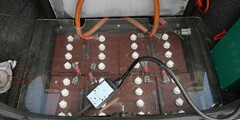What California's Power Grid Can Learn From Cell Service During Hurricane Sandy

Power outages in the northeastern U.S. on October 30 | Screen capture from Google's crisis map
As an unprecedented storm ravages the East Coast, we at ReWire hope everyone you care about is safe and sound. As our eastern friends start to repair and rebuild, it looks like California's vital power grid can learn a lesson from what went right during the storm's assault on the Eastern Seaboard.
Related


Explained: Understanding Distributed Generation
As writer Christopher Mims points out in an article today on the website Quartz, millions of East Coast residents woke up this morning without electrical power but with spotty cell service. The reason? In the wake of Hurricane Katrina, in which 75% of New Orleans' cell phone communication infrastructure was put out of commission, an increasing number of cell towers have been equipped with battery storage and backup power. As Mims reports:
[I]n 2007 the US Federal Communications Commission released a "Katrina Panel Order" (pdf) recommending that almost all of the nation's cell phone towers and other important pieces of the mobile infrastructure be equipped with at least eight hours of backup power. In 2008, the wireless industry sued to block the rule, and the Office of Management and Budget eventually killed it.... In arguing against these rules, carriers said that they had learned Katrina's lessons, and were taking steps to install more backup power on their towers. Verizon, for example, claimed that 90% of its cell towers already had some form of backup power.
Said backup power comes in various forms, from diesel and natural gas generators to large battery banks to combinations of the above. Depending on the location and transmission volume, cell towers with backup power can function for between 8 and 48 hours after power goes out.
The result, at least in parts of the area hit by Hurricane Sandy, is that people sheltering against tropical storm-force winds with no electrical power could still get news out to friends and family. There were and are still interruptions in coverage: Strong winds can damage aerial receivers and transmitters, and once your text message gets to thee tower, it travels through a set of underground cables that are potential vulnerable to damage from floods and fires. Over some of the area affected by Sandy, 3G and voice service went out while 4G remained in service.
Nonetheless, the relatively decentralized mobile phone system is in much better shape than northeastern power companies' grids, of whose customers millions are currently without power. Electrical power utilities' continuing dependence on centralized power generation and transmission makes the grid more and more fragile to disruption -- whether by accident, act of nature, or deliberate sabotage.
The region's utilities are now working to repair transmission and bring power plants back online. It will be interesting to see how the high adoption of rooftop solar in New Jersey, which took the brunt of the storm, factors into that repowering -- at least for those panels that didn't blow away in the face of the storm.
The decentralized mobile phone network survived better than the heavily centralized, fragile power generation and transmission grid. Those of us in disaster-prone California would do well to pay attention to this lesson. We don't get so many hurricanes, of course, but we enjoy a range of other disasters from our emblematic earthquakes to wildfires, floods and tsunamis. Californians know well it's not a question of if a disaster will strike, but when. Localized power generation as with rooftop solar, and power storage in smart microgrids will likely prove a much safer way of meeting our power needs when the next Big One hits.
ReWire is dedicated to covering renewable energy in California. Keep in touch by liking us on Facebook, and help shape our editorial direction by taking this quick survey here.


